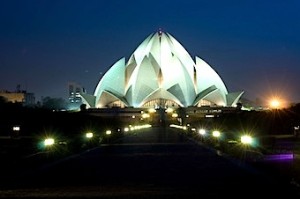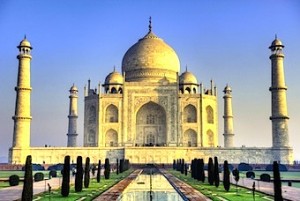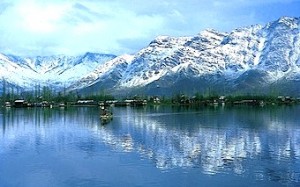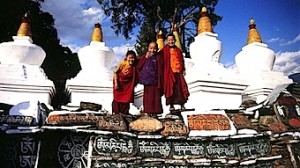The Government of India is introducing new tourism initiatives, including E-Ticketing for major monuments and a Tourist Helpline. ITTN News & Features Editor Neil Steedman reports on some of the most popular destinations for Irish visitors – and others less visited. 
The Government of India has set a target to achieve a one percent share of global tourism arrivals by next year, and helping to achieve that will be the allocation by the Ministry of Tourism of Rs5 billion (€70m) for the development of five theme-based tourist circuits: Ganga, Krishna, Buddha, North East, and Kerala. A Cruise Plan will also be ready for implementation soon, while a comprehensive plan is being prepared with the Ministry of Environment and Forests for promoting wildlife tourism.
The Government has also identified 25 monuments for an Adarsh Smarak Campaign, in which they will be developed as model monuments with E-Ticketing. The path-breaking initiative has already begun with the launch of E-Ticketing at the Taj Mahal in Agra and Humayun’s Tomb in Delhi.
Similarly, in another initiative, a 24×7 Incredible India Tourist Helpline has been launched, along with Special Welcome Cards for foreign tourists arriving at nine international airports.
Tourist Visas
Holders of passports of 43 countries are now eligible to apply for a Tourist Visa on Arrival in India – but neither Ireland nor Britain is included. However, Irish and British passport holders can now apply for an Indian Visa online, at http://indianvisaonline.gov.in/visa/, and then submit their printed application with supporting documentation at the Indian Embassy in Dublin.
The passport should have at least six months validity from the date of arrival in India and should have at least two blank pages for stamping by the Immigration Officer.
Delhi
Qutub Minar: This 72-metre tower, tapering from a 15-metre diameter at the base to 2.5 metres at the top, is the earliest specimen of Muslim architecture. A World Heritage Site monument built by the first Muslim ruler of India, Qutub-ud-din Aikab of the Delhi Sultanate, the Qutub Minar is one of the most famous attractions in India. Nearby is Quwwat-ul-Islam, possibly India’s oldest mosque, and, dating back to the 4th century AD, the Iron Pillar that never rusts.
Humayun’s Tomb: A forerunner of the Taj Mahal in Agra, the mausoleum of Humayun, the second Mughal emperor, was built by the emperor’s wife, Haji Begum. The tomb was completed in 1569 AD, is set in a formal Persian garden, and features an artful combination of red sandstone and white marble.
Red Fort: Built by Shah Jahan, the palace fortress, is known as the Red Fort because of the red sandstone fabric of its rampart walls, with its halls, palaces, pavilions and serene gardens was completed in 1648. Within its enclosure are many buildings, including the Diwan-i-Khas (also known as Shah Mahal) and the Rang Mhal (also called Imtiyaz Mahal or palace of distinctions).

Bahai Lotus Temple: Shaped like the sacred lotus flower, this extraordinary temple is a major highlight of Delhi. Designed by Iranian-Canadian architect FariburzSahba in 1986, it is situated at Kalkaji and has 27 immaculate white-marble petals. It is open to the adherents of all faiths who come here to pray or meditate silently according to their own religion.
India Gate: One of the main attractions of Delhi, India Gate, was built as a memorial to commemorate the 70,000 India soldiers who died in World War I. Designed by Sir Edwin Lutyens, the monument was completed in 1931.
Agra
Taj Mahal: India’s most fascinating and beautiful monument, and a World Heritage Site, the Taj Mahal was completed in 1653 AD by the Mughal Emperor Shah Jahan as the final resting place for his favourite Queen Mumtaz. This perfectly symmetrical monument took 22 years (1630-1652) of hard labour and 20,000 workers, masons and jewellers to build and is set amid landscaped gardens. It was built by the Persian architect, Ustad Ahmad Lahauri.

Agra Fort: Another World Heritage Site is the imposing fort on the banks of the river Yamuna, commissioned by Akbar in 1565 AD. It encloses numerous palaces and houses such as the Moti Masjid, Diwan-i-Am, Diwan-i-Khas, Musamman Burj, Jehangiri Mahal, Khaas Mahal, and Sheesh Mahal.
Sikandra: The last resting place of the Mughal Emperor Akbar, Sikandra lies on the outskirts of Agra city. The Emperor had completed the tomb and laid out a beautiful garden, in his lifetime itself. However, the topmost portion of the mausoleum was completed by his son, Jehangir.
Kashmir
Srinagar: The Jewel in Srinagar’s Crown, Dal Lake, lies at the foot of the Shridhara (Zabarwan) mountain. A vast stretch of water reflecting the carved wooden balconies of the houseboats and the misty peaks of the Pir Panjal Mountains, the lake is divided by causeways into four parts.

Leh: In the capital of Ladakh, Leh Khar Palace stands like a sentinel overlooking the town, and inside old wall paintings depict the life of Buddha, while Leh Monastery houses a solid golden statue of the Buddha, painted scrolls, ancient manuscripts and wall paintings. Built by Singe Namgyal as a tribute to his Muslim mother, Leh Mosque is an exquisite work of Turko Iranian architecture and stands majestically in the main bazaar.
North East
Assam: Guwahati is the principal centre of socio-cultural, industrial, trade and commerce activities of the entire region. Hugging the shores of the turbulent Brahmaputra, Guwahati is the gateway to the enchanting North East. The Light of the East, Pragjyotishpura, as it was once known, is said to have been a vast kingdom during the epic period of the Mahabharata.

Sikkim: The capital Gangtok, situated at a height of 1,700 metres, rose to prominence as a popular Buddhist pilgrimage site after the construction of the Enchey Monastery in 1840. Today, Gangtok is a centre of Tibetan Buddhist culture and learning, with the presence of several monasteries, including Rumtek, religious educational institutions, and centres for Tibetology. The many Tibetan Buddhist monasteries in the west of Sikkim include Tashiding and Pemayangtse.
Nagaland: The capital Kohima, located at an altitude 1,444 metres, is the land of the Angami Naga tribe and is so called because the British could not pronounce “kewhira” (the name of the village), which means “the land where all travellers are welcome”. Kohima was the first seat of modern administration as the headquarters of Naga Hills District (then under Assam) in 1879. The Battle of Kohima during World War II was a turning point in the Burma Campaign, when the Japanese failed to gain a foothold against the Allies in South-East Asia.
Meghalaya: The capital Shillong is located in the Khasi hills at an altitude of 1,496 metres. This city, the seat of government since the consolidation of the British administration in this part of India more than a century ago, has a charm all its own with natural scenic beauty enhanced by waterfalls, brooks, pine grooves and gardens. The place, the people, the flora and fauna and the climate all combine to make Shillong an ideal resort throughout the year.
Wildlife
For many people, the two words ‘India’ and ‘wildlife’ immediately summon up the image of tigers, quickly followed by elephants, but India offers a rich diversity of wildlife along with more than 70 national parks and 400 wildlife sanctuaries, including bird sanctuaries.

As well as tiger and elephant, visitors can see the one-horned rhinoceros, snow leopard, panther, wild buffalo, wild bear, wild ass, crocodile, deer, blackbuck, porcupine, the Great Indian Bustard … and many more species!
Kaziranga National Park in Assam, for example, is inhabited by the world’s largest population of one-horned rhinoceroses, as well as many mammals, including tigers, elephants, panthers and bears, and thousands of birds.
Keoladeo National Park, a former duck-hunting reserve of the Maharajas, is one of the major wintering areas for large numbers of aquatic birds from Afghanistan, Turkmenistan, China and Siberia. Some 364 species of birds, including the rare Siberian crane, have been recorded in the park.
On a gentle slope in the foothills of the Himalayas, where wooded hills give way to alluvial grasslands and tropical forests, the Manas Wildlife Sanctuary is home to a great variety of wildlife, including many endangered species, such as the tiger, pygmy hog, Indian rhinoceros and Indian elephant.




